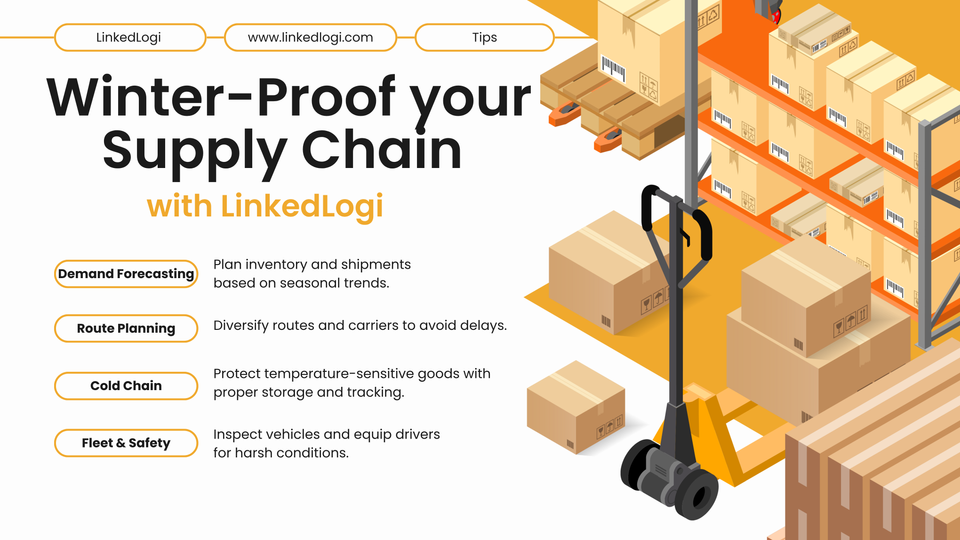Winter Supply Chain Readiness: How Businesses Can Prevent Disruptions Before the Cold Hits

When temperatures drop, logistics networks face their biggest seasonal challenge. From snow-blocked highways to delayed ports and frozen containers, winter brings disruptions that can paralyze supply chains. The good news? With strategic planning, businesses can not only mitigate these risks but also turn the cold months into an advantage.
At Linkedlogi, we believe that winter preparation isn’t just about reacting to the weather—it’s about proactive resilience.
Why Winter Impacts Supply Chains So Severely
Winter weather affects logistics across multiple dimensions—transportation, warehousing, inventory, and even labor management.
- Transportation Disruptions: Snowstorms and icy roads can halt truck movement. Airlines face flight cancellations, and ports may close due to unsafe conditions.
- Increased Transit Time: Even minor delays ripple through the supply chain, leading to missed delivery deadlines.
- Warehouse Challenges: Maintaining optimal temperature and humidity is crucial to prevent product damage—especially for perishables, chemicals, and electronics.
- Labor Shortages: Absenteeism rises due to illness or commuting issues, slowing operations.
- Cost Escalation: Fuel inefficiencies and emergency freight rerouting increase expenses.
In short, the entire logistics ecosystem becomes fragile. But companies with predictive planning and data-driven logistics can maintain operational flow and customer satisfaction.
1. Weather-Responsive Demand Forecasting
Data is your first line of defense. Seasonal demand shifts occur in winter—retail peaks before holidays, while construction and manufacturing might slow down.
Using predictive analytics, businesses can forecast not only demand patterns but also weather-driven disruptions.
At Linkedlogi, we encourage clients to integrate real-time meteorological data with their ERP and transport management systems (TMS) to anticipate slowdowns.
Example: A food supplier might reroute shipments from northern to southern ports before a predicted snowstorm, saving both time and cost.
2. Route Diversification and Carrier Partnerships
Relying on one transport route or a single carrier can be disastrous in winter. Instead:
- Build redundant routes for critical lanes.
- Partner with multiple carriers to distribute risk.
- Use GPS-based dynamic routing to monitor real-time road conditions.
A diversified network ensures flexibility. If one highway closes due to snow, the system can reroute instantly without disrupting the delivery chain.
3. Cold Chain Reinforcement
For temperature-sensitive goods—like pharmaceuticals, chemicals, or food—cold chain integrity is non-negotiable.
Steps to ensure resilience:
- Use smart temperature sensors and IoT trackers for real-time monitoring.
- Regularly inspect reefer containers for insulation and compressor efficiency.
- Train drivers in temperature management and emergency protocols.
- Always maintain contingency stock at regional cold storage facilities.
A robust cold chain not only safeguards products but also ensures compliance with global standards like GDP (Good Distribution Practice).
4. Warehouse Winterization
Warehouses often become weak links during winter. Temperature fluctuations can damage stored goods or cause energy inefficiencies.
Checklist for winterizing:
- Seal doors, windows, and loading docks to prevent heat loss.
- Install humidity control systems for sensitive products.
- Schedule equipment maintenance (heating units, forklifts, conveyor belts).
- Stock de-icing materials and ensure outdoor access routes remain clear.
Well-prepared warehouses don’t just endure winter—they thrive by reducing losses and maintaining worker comfort.
5. Fleet Preparedness and Driver Safety
Truck maintenance is vital. A single breakdown in freezing conditions can cause cascading delays.
To prepare:
- Conduct seasonal inspections for brakes, batteries, fluids, and tire tread.
- Equip fleets with snow chains, defrost kits, and emergency supplies.
- Train drivers on defensive winter driving techniques.
- Implement geo-tracking to ensure safety and timely updates.
Companies that invest in driver welfare experience fewer delays and higher morale.
6. Emergency Logistics Protocols
Even the best plans can face unexpected crises. Hence, building business continuity protocols is essential:
- Create escalation hierarchies and communication templates.
- Partner with local 3PLs or micro-hubs near high-risk zones.
- Maintain a rapid response inventory pool for critical goods.
- Ensure digital connectivity between all nodes in the network.
At Linkedlogi, we help partners design such protocols so that emergencies become manageable—not catastrophic.
7. Technology as the Backbone
Modern logistics resilience depends on technology integration:
- AI-driven predictive analytics for anticipating disruptions.
- IoT sensors for asset visibility.
- Blockchain for documentation and transparency.
- Cloud-based dashboards for centralized control.
The more digitized your supply chain, the less susceptible it becomes to seasonal shocks.
8. Case Study: How a Global FMCG Brand Handled Winter Delays
In 2023, a major FMCG company faced port slowdowns in northern Europe. By integrating weather analytics into their logistics dashboard and working with Linkedlogi’s routing model, they diverted shipments to southern ports 48 hours before the storm. Result: Zero stockouts, 12% cost savings, and improved delivery reliability.
Conclusion: Build a Winter-Resilient Supply Chain Today
Winter disruptions are inevitable—but chaos isn’t.
Preparedness, predictive analytics, and proactive communication make all the difference.
At Linkedlogi, we help businesses design agile and weather-proof logistics systems that sustain performance year-round.
The key isn’t avoiding winter—it’s learning how to move confidently through it.
